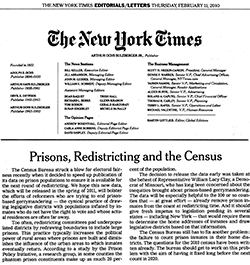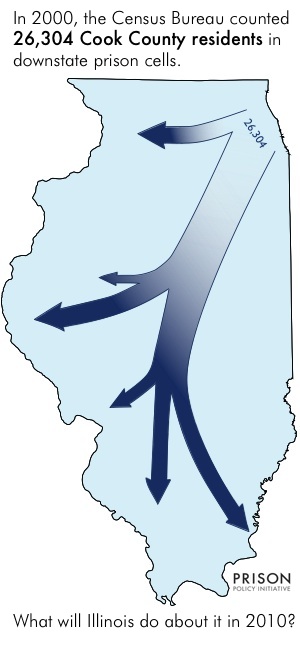Except on Census day, prison district politicians do not believe that incarcerated people are residents of their districts.
by Peter Wagner,
February 15, 2010
With the Census almost here, some politicians have drawn their attention to defending the Census Bureau’s practice of counting incarcerated people as residents of correctional facilities in their districts. The politicians’ aim is to claim as many people in the area as residents of their district. Claiming more people — even if they can’t vote and are legal residents of other parts of the state — can be a benefit at redistricting time. Having an artificially high population allows them to create districts with fewer real constituents to be accountable to.
The politicians’ defense of the Census rule for prison counting doesn’t hold water. One argument they make goes like this: Sometimes people in prison use the local hospitals, so we should be able to claim them as residents. But people who are passing through town and staying in local hotels temporarily use the local hospitals too.
As with every other group the Census counts, what matters is whether people in prison are considered residents of the community that contains the prison. Except for incarcerated people, the residence rule the Census uses consistently results in counting people at their homes.
I’ve frequently written about the New York State Constitution’s definition of residence, which explicitly says that confinement in a public prison does not change a person’s residence. Despite the official constitutional definition, I’ve also looked to see whether county officials actually consider incarcerated people to be residents of their communities. And the result?
When the Census is not underway and the news cameras are not around, no politician treats the people in local prison cells as residents or constituents.
Continue reading →
Justin Levitt at the Brennan Center for Justice says the Census Bureau's new prison count data is a big step forward for democracy.
by Peter Wagner,
February 14, 2010
Justin Levitt at the Brennan Center for Justice has a great new article explaining the importance for redistricting of the Census Bureau’s change in how the prison count data will be published:
Rep Clay says Census Bureau is giving state and local governments an opportunity to stand up for fairness and justice.
by Peter Wagner,
February 13, 2010
FOR IMMEDIATE RELEASE: February 12, 2010
MEDIA CONTACT:
STEVEN ENGELHARDT (314) 504-4029
Says Decision Will Improve Accuracy, Restore Fairness, Reverse a Historic Injustice
WASHINGTON — Congressman Wm. Lacy Clay (D) Missouri, Chairman of the House Subcommittee on Information Policy, Census & National Archives has negotiated a ground-breaking agreement with the U.S. Census Bureau that will change how census counts of prisoners are reported to state and local governments. The policy change, which moves up the date when counts of incarcerated populations are reported, could potentially result in increased urban and suburban representation in state legislatures and local governments.
“I want to commend U.S. Census Director Dr. Robert Groves and his staff for acting to improve accuracy, restore fairness and reverse historic patterns of injustice that have been applied to prisoners for many years,” said Chairman Clay. “The impact of this decision is enormous. States and local governments will now have the opportunity to do the right thing and prevent the overrepresentation of areas where prisons are located.”
Continue reading →
by Peter Wagner,
February 13, 2010
The Census Bureau’s decision to change how census counts of prisoners are reported to state and local governments is getting a lot of press. Samples include:
 Prisons, Redistricting and the Census New York Times editorial, February 11, 2010
Prisons, Redistricting and the Census New York Times editorial, February 11, 2010 - States get new leeway to tally prisoners in census, by Hope Yen, Associated Press, February 11, 2010
- New Option for the States on Inmates in the Census, by Sam Roberts, New York Times, February 11, 2010
- Reformers Score a Census Victory…by Skipping Prisoners? by Matt Kelley, Change.org, February 11, 2010
Prisons don't pay property taxes. But violating the state and federal constitutions by cheating during the redistricting process is not the solution.
by Peter Wagner,
February 11, 2010
I usually don’t publish and respond to anonymous email that comes in, but I just received a message that almost perfectly sums up the talking points of the supporters of prison-based gerrymandering. While I can’t confirm it’s authenticity beyond the fact that it was sent from upstate New York, this is an illustration of some of the misunderstandings that underlie the debate about ending prison-based gerrymandering in the state:
Continue reading →
Census Bureau commits to a new data product that will enable states and counties to avoid prison-based gerrymandering.
February 10, 2010
For Immediate Release
February 10, 2010
Bureau’s Action Is First Step Toward Ending Prison-Based Gerrymandering
Contact:
Jeanine Plant-Chirlin, Brennan Center for Justice, (212) 998-6289, jeanine.plant-chirlin@nyu.edu
Tim Rusch, Demos, (212) 389-1407, trusch@demos.org
Peter Wagner, Prison Policy Initiative (413) 527-0845
New York, NY— This week, the Census Bureau has agreed to produce a new data product that will assist state and local governments in avoiding prison-based gerrymandering, whereby districts that contain prisons are given extra representation in the legislature. The move was commended by a national network of advocates working to reform state redistricting practices, including the Prison Policy Initiative, Demos, the Brennan Center for Justice at NYU School of Law, NAACP Legal Defense and Educational Fund (LDF), and The National Coalition.
Continue reading →
It's time New York demanded the census do what it was intended to do: Count the populations of its real communities, not tamper with its political scales.
by Peter Wagner,
February 9, 2010
Glenn Martin has a great letter to the editor in last week’s Albany Times Union (February 5, 2010):
Don’t Politicize The Census
While sparsely populated upstate needs all the legislative representation it can muster, this representation must not come at the expense of destitute urban communities whose problems already stem from a disproportionate lack of resources and advocacy.
Census guidelines allow upstate prison communities to count nonvoting inmates as residents in order to increase legislative representation, while the prisoners’ underserved hometown communities lose out (“Inmate census rule criticized,” Jan. 29).
State parole laws dictate that upon release, prisoners must return to the county of their conviction — which is usually the county of their last known address. By this logic, inmates should be counted as residents of that county throughout incarceration, even if their prison is located upstate.
Continue reading →
Rebutting misinformation, I explain in a letter to the editor that revising the Census and drawing fair districts would not affect a prison town's funding.
by Peter Wagner,
February 7, 2010
A state-wide campaign is underway to end prison-based gerrymandering in New York State. Unfortunately, a misinformation campaign threatens those efforts. Today, the Elmira Star-Gazette in upstate New York printed
my letter to the editor:
Mayor Tonello is concerned that a bill to change how prisoners are counted for redistricting purposes would hurt Elmira’s budget. [" Officials: Changing how census counts inmates would hurt region", February 1] This concern is misplaced.
Continue reading →
"Did you know that your vote counts more if you live near a prison? That's what the census says." Andrew Paley reports on our Illinois research in Medill Reports.
by Peter Wagner,
February 6, 2010
Andrew Paley has a great story about our prison-based gerrymandering in Illinois report in Medill Reports::
Census engaged in ‘prison-based gerrymandering,’ report says.
BY ANDREW PALEY
Did you know that your vote counts more if you live near a prison? That’s what the census says.
by Peter Wagner,
February 4, 2010
A vote in Somerset County Maryland means that ending prison-based gerrymandering is getting closer.
An NAACP- and ACLU-led group of county leaders and community members, called the Somerset County Task Force on Diversity, has called for the county to explore the possibility of disregarding the population at the state prison when the county next updates its county legislative lines after the 2010 Census. In a 4-1 vote, the County Commission endorsed the Task Force’s recommendations.
Continue reading →
 Prisons, Redistricting and the Census
Prisons, Redistricting and the Census



